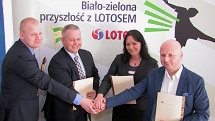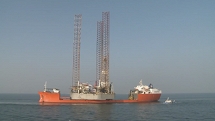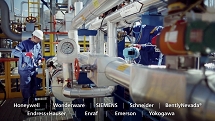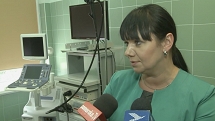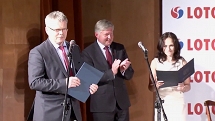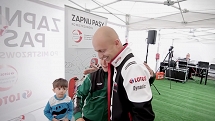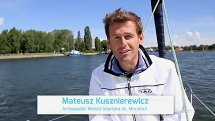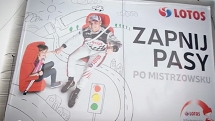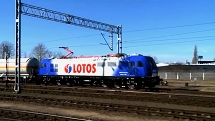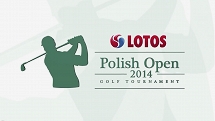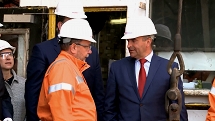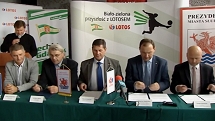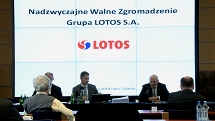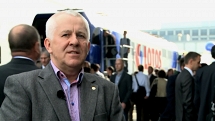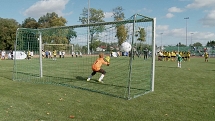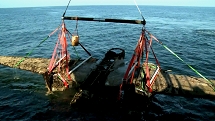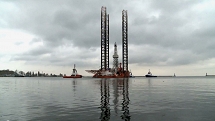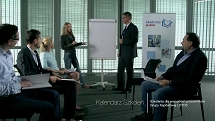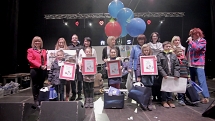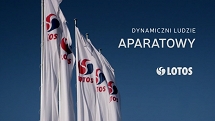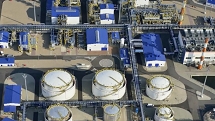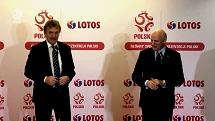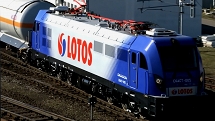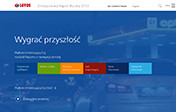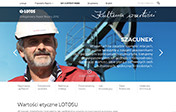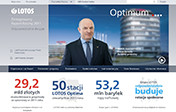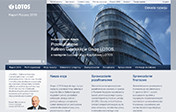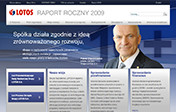-
Financial information
The past year ushered in a series of challenges for the companies in the fuel sector. The decisions made by us have demonstrated that we are able to take rapid steps to adapt to a demanding environment and ensure the desired profitability for our projects.
-
Segment performance
The segmental management model we have implemented enhances management efficiency, delivering cost and revenue synergies across the organization.
-
Letter from the Vice-President of the Board
2014 ushered in a series of challenges for the companies in the fuel sector. The decisions made by the LOTOS Group have demonstrated that we are able to take rapid steps to adapt to a demanding environment and ensure the desired profitability for our projects.
-
Business environment
The key factor that had a strong impact on both the global and Polish petroleum markets in 2014, with significant consequences for the LOTOS Group’s performance, was the price of crude oil, which also determined the price of petroleum products.
-
Strategic objectives
The LOTOS Group’s Strategy is designed to strengthen our position as a strong, innovative and efficient business which plays a major role in ensuring national energy security.
-
Business model
Our operations consist in crude oil production and processing, as well as wholesale and retail sale of petroleum products, among which are: fuels (unleaded gasoline, diesel oil and light fuel oil), heavy fuel oil, bitumens, aviation fuel, naphtha, propane-butane LPG and base oils.
-
Risk and opportunities
At the LOTOS Group, we identify a range of diverse risks, which may affect all areas of our business. The key risks in terms of their impact on our operations are the financial risks as well as risks affecting the exploration and production area. In the analysis of the risks, we also factor in issues related to sustainable development.
-
Key data 2014
With revenue of ca. PLN 28.5bn in 2014, we rank fourth in the group of 500 largest businesses in Poland.
GRI and UN Global Compact Content Index
The Table below can prove helpful in finding the exact place where specific information or result data required by the Global Reporting Initiative as well as resulting from the adoption and implementation of ten principles of the United Nations Global Compact by Grupa LOTOS has been published in the Report.
Reporting application level indicators:
- full
- / partial
- none
| Global Reporting Initiative (GRI) Indicator | Reporting Application Level | Chapter of The 2013 Annual Report | Comments | Un Global Compact Principles | Assurance | ||||||||||||||||||||||||||||||||||||||||||||
|---|---|---|---|---|---|---|---|---|---|---|---|---|---|---|---|---|---|---|---|---|---|---|---|---|---|---|---|---|---|---|---|---|---|---|---|---|---|---|---|---|---|---|---|---|---|---|---|---|---|
Strategy and Analysis |
|||||||||||||||||||||||||||||||||||||||||||||||||
| 1.1. Statement from the most senior decision-maker of the organization about the relevance of sustainability to the organization and its strategy. |
|
The Organization and its Report [1] | |||||||||||||||||||||||||||||||||||||||||||||||
| 1.2. Description of key impacts, risks, and opportunities. |
|
Risks and opportunities [1] | |||||||||||||||||||||||||||||||||||||||||||||||
Organizational Profile |
|||||||||||||||||||||||||||||||||||||||||||||||||
| 2.1. Name of the organization. |
|
The Organization and its Report [1] | |||||||||||||||||||||||||||||||||||||||||||||||
| 2.2. Primary brands, products, and/or services. |
|
Business strategy and model [1] | |||||||||||||||||||||||||||||||||||||||||||||||
| 2.3. Operational structure of the organization, including main divisions, operating companies, subsidiaries, and joint ventures. |
|
The Organization and its Report [1] | |||||||||||||||||||||||||||||||||||||||||||||||
| 2.4. Location of organization’s headquarters. |
|
The Organization and its Report [1] Useful information [2] |
|||||||||||||||||||||||||||||||||||||||||||||||
| 2.5. Number of countries where the organization operates, and names of countries with either major operations or that are specifically relevant to the sustainability issues covered in the report. |
|
The Organization and its Report [1] | |||||||||||||||||||||||||||||||||||||||||||||||
| 2.6. Nature of ownership and legal form. |
|
The Organization and its Report [1] [2] | |||||||||||||||||||||||||||||||||||||||||||||||
| 2.7. Markets served (including geographic breakdown, sectors served, and types of customers/beneficiaries. |
|
Business strategy and model [1] | |||||||||||||||||||||||||||||||||||||||||||||||
| 2.8. Scale of the reporting organization. |
|
Business strategy and model [1] | |||||||||||||||||||||||||||||||||||||||||||||||
| 2.9. Significant changes during the reporting period regarding size, structure, or ownership. |
|
The Organization and its Report [1] | |||||||||||||||||||||||||||||||||||||||||||||||
| 2.10. Awards received in the reporting period. |
|
The Organization and its Report [1] Useful information [2] |
|||||||||||||||||||||||||||||||||||||||||||||||
Report Parameters |
|||||||||||||||||||||||||||||||||||||||||||||||||
| Report Profile | |||||||||||||||||||||||||||||||||||||||||||||||||
| 3.1. Reporting period. |
|
The Organization and its Report [1] | |||||||||||||||||||||||||||||||||||||||||||||||
| 3.2. Date of most recent previous report. |
|
The Organization and its Report [1] | |||||||||||||||||||||||||||||||||||||||||||||||
| 3.3. Reporting cycle. |
|
The Organization and its Report [1] | |||||||||||||||||||||||||||||||||||||||||||||||
| 3.4. Contact point for questions regarding the report or its contents. |
|
Useful information [1] | |||||||||||||||||||||||||||||||||||||||||||||||
3.5. Process for defining report content, including:
|
|
The Organization and its Report [1] | |||||||||||||||||||||||||||||||||||||||||||||||
| 3.6. Boundary of the report (e.g. countries, divisions, subsidiaries, leased facilities, joint ventures, suppliers). |
|
The Organization and its Report [1] | |||||||||||||||||||||||||||||||||||||||||||||||
| 3.7. State any specific limitations on the scope or boundary of the report. |
|
The Organization and its Report [1] | |||||||||||||||||||||||||||||||||||||||||||||||
| 3.8. Basis for reporting on joint ventures, subsidiaries, leased facilities, outsourced operations, and other entities that can significantly affect comparability from period to period and/or between organizations. |
|
The Organization and its Report [1] | |||||||||||||||||||||||||||||||||||||||||||||||
| 3.9. Data measurement techniques and the bases of calculations, including assumptions and techniques underlying estimations applied to the compilation of the Indicators and other information in the report. |
|
The Organization and its Report [1] | |||||||||||||||||||||||||||||||||||||||||||||||
| 3.10. Explanation of the effect of any re-statements of information provided in earlier reports, and the reasons for such re-statement (e.g. mergers/acquisitions, change of base years/periods, nature of business, measurement methods). |
|
The Organization and its Report [1] | |||||||||||||||||||||||||||||||||||||||||||||||
| 3.11. Significant changes from previous reporting periods in the scope, boundary, or measurement methods applied in the report. |
|
The Organization and its Report [1] | |||||||||||||||||||||||||||||||||||||||||||||||
| GRI Content Index | |||||||||||||||||||||||||||||||||||||||||||||||||
| 3.12. Table identifying the location of the Standard Disclosures in the report. |
|
GRI and UN Global Compact Content Index | |||||||||||||||||||||||||||||||||||||||||||||||
| Assurance | |||||||||||||||||||||||||||||||||||||||||||||||||
| 3.13. Policy and current practice with regard to seeking external assurance for the report. |
|
The Organization and its Report [1] [2] | |||||||||||||||||||||||||||||||||||||||||||||||
Governance, Commitments, and Engagement |
|||||||||||||||||||||||||||||||||||||||||||||||||
| Governance | |||||||||||||||||||||||||||||||||||||||||||||||||
| 4.1. Governance structure of the organization, including committees under the highest governance body responsible for specific tasks, such as setting strategy or organizational oversight. |
|
Ethics and corporate governance [1] [2] [3] | |||||||||||||||||||||||||||||||||||||||||||||||
| 4.2. Indicate whether the Chair of the highest governance body is also an executive officer. |
|
Ethics and corporate governance [1] | |||||||||||||||||||||||||||||||||||||||||||||||
| 4.3. For organizations that have a unitary board structure, state the number and gender of members of the highest governance body that are independent and/or non-executive members. |
|
Ethics and corporate governance [1] [2] | |||||||||||||||||||||||||||||||||||||||||||||||
| 4.4. Mechanisms for shareholders and employees to provide recommendations or direction to the highest governance body. |
|
Ethics and corporate governance [1] | |||||||||||||||||||||||||||||||||||||||||||||||
| 4.5. Linkage between compensation for members of the highest governance body, senior managers, and executives (including departure arrangements), and the organization’s performance (including social and environmental performance). |
|
Ethics and corporate governance [1] [2] | |||||||||||||||||||||||||||||||||||||||||||||||
| 4.6. Processes in place for the highest governance body to ensure conflicts of interest are avoided. |
|
Ethics and corporate governance [1] [2] | |||||||||||||||||||||||||||||||||||||||||||||||
| 4.7. Process for determining the composition, qualifications, and expertise of the members of the highest governance body and its committees, including any consideration of gender and other indicators of diversity. |
|
Ethics and corporate governance [1] | |||||||||||||||||||||||||||||||||||||||||||||||
| 4.8. Internally developed statements of mission or values, codes of conduct, and principles relevant to economic, environmental, and social performance and the status of their implementation. |
|
Business strategy and model [1] | |||||||||||||||||||||||||||||||||||||||||||||||
| 4.9. Procedures of the highest governance body for overseeing the organization’s identification and management of economic, environmental, and social performance, including relevant risks and opportunities, and adherence or compliance with internationally agreed standards, codes of conduct, and principles. |
|
Ethics and corporate governance [1] | |||||||||||||||||||||||||||||||||||||||||||||||
| 4.10. Processes for evaluating the highest governance body’s own performance, particularly with respect to economic, environmental, and social performance. |
|
Ethics and corporate governance [1] | |||||||||||||||||||||||||||||||||||||||||||||||
| Commitments To External Initiatives | |||||||||||||||||||||||||||||||||||||||||||||||||
| 4.11. Explanation of whether and how the precautionary approach or principle is addressed by the organization. |
|
Risks and opportunities [1] [2] [3] Business strategy and model [4] |
|||||||||||||||||||||||||||||||||||||||||||||||
| 4.12. Externally developed economic, environmental,and social charters, principles, or other initiatives to which the organization subscribes or endorses. |
|
Ethics and corporate governance [1] | |||||||||||||||||||||||||||||||||||||||||||||||
4.13. Memberships in associations (such as industry associations) and/or national/international advocacy organizations in which the organization:
|
|
The Organization and its Report [1] | |||||||||||||||||||||||||||||||||||||||||||||||
| Stakeholder Engagement | |||||||||||||||||||||||||||||||||||||||||||||||||
| 4.14. List of stakeholder groups engaged by the organization. |
|
Results and prospects [1] | |||||||||||||||||||||||||||||||||||||||||||||||
| 4.15. Basis for identification and selection of stakeholders with whom to engage. |
|
Results and prospects [1] | |||||||||||||||||||||||||||||||||||||||||||||||
| 4.16. Approaches to stakeholder engagement, including frequency of engagement by type and by stakeholder group. |
|
Results and prospects [1] | |||||||||||||||||||||||||||||||||||||||||||||||
| 4.17. Key topics and concerns that have been raised through stakeholder engagement, and how the organization has responded to those key topics and concerns, including through its reporting. |
|
Results and prospects [1] | |||||||||||||||||||||||||||||||||||||||||||||||
Management Approach and Performance Indicators |
|||||||||||||||||||||||||||||||||||||||||||||||||
Economy |
|
Results and prospects [1] | |||||||||||||||||||||||||||||||||||||||||||||||
| Environment |
|
Business strategy and model [1] | |||||||||||||||||||||||||||||||||||||||||||||||
| Labor Practices & Decent Work |
|
||||||||||||||||||||||||||||||||||||||||||||||||
| Human Rights |
|
Business strategy and model [1] Results and prospects [2] |
|||||||||||||||||||||||||||||||||||||||||||||||
| Society |
|
Business strategy and model [1] Results and prospects [2] |
|||||||||||||||||||||||||||||||||||||||||||||||
| Product Responsiblity |
|
Business strategy and model [1] | |||||||||||||||||||||||||||||||||||||||||||||||
Performance Indicators |
|||||||||||||||||||||||||||||||||||||||||||||||||
Economic Performance Indicators |
|||||||||||||||||||||||||||||||||||||||||||||||||
| Aspect: Economic Performance | |||||||||||||||||||||||||||||||||||||||||||||||||
| EC1. Direct economic value generated and distributed, including revenues, operating costs, employee compensation, donations and other community Investments, retained earnings, and payments to capital providers and governments. |
|
GRI and UN Global Compact Content Index |
In 2014, Grupa LOTOS paid PLN 10,900,341 thousand in taxes to the Polish state (including corporate income tax, value added tax, excise tax, fuel charge and property tax). In 2014, the LOTOS Group paid PLN 11,403,606 thousand in taxes to the states in which it operates taxes (including corporate income tax, value added tax, excise tax, fuel charge and property tax). |
||||||||||||||||||||||||||||||||||||||||||||||
| EC2. Financial implications and other risks and opportunities for the organization’s activities due to climate change. |
|
Risks and opportunities [1] [2] | |||||||||||||||||||||||||||||||||||||||||||||||
| EC3. Coverage of the organization’s defined benefit plan obligations. |
|
Results and prospects [1] | |||||||||||||||||||||||||||||||||||||||||||||||
| EC4. Significant financial assistance received from government. |
|
GRI and UN Global Compact Content Index Consolidated Financial Statement [1] [2] |
Grants are mainly licences received free of charge and grants received from EcoFund for the use of waste gas from the offshore oil production facility for heating purposes.
Moreover, the LOTOS Group makes use of government assistance, as regulated by IAS 20 concerning "Accounting for Government Grants and Disclosure of Government Assistance". Until April 30th 2011, Grupa LOTOS was a beneficiary of tax relief available to producers of biocomponents, under the Act of February 15th 1992, Corporate Income tax (consolidated text: Dz.U. of 2011, No 74, item 397) - Art. 19a. The public assistance granted within the quoted regulations was approved by the decision of the European Commission No. N 57/08 of September 18th 2009, concerning authorisation for state operated assistance in the area of biofuels. This relief has enabled biofuel producers to deduct from their payable income tax up to 19% of the surplus value of their produced biofuels, over the value of their produced liquid fuels of the same calorific value, calculated at average prices. European Commission approval for the tax relief expired on April 30th 2011, and the unsettled amount of the relief is accounted for in current prepayments for corporate income tax. The deferred tax resulting from the biocomponent relief was presented in Note 10.3 and its tax effect in Note 10.2 of Additional information and clarifications to the LOTOS Group's Consolidated Financial Statement for the year 2014. The LOTOS Group is also taking advantage of the relief for acquiring new technologies under the Act of February 15th 1992 on corporate income tax (consolidated text: Dz. U. of 2011, No. 74, item 397) - Art. 18b. This enables the LOTOS Group to deduct from payable income tax no more than 50% of its expenditure on the purchase of new technologies. The effect of this relief for the LOTOS Group's Consolidated Financial Statements for the year 2014 was insignificant. |
||||||||||||||||||||||||||||||||||||||||||||||
| Aspect: Market presence including local content | |||||||||||||||||||||||||||||||||||||||||||||||||
| EC5. Range of ratios of standard entry level wage by gender compared to local minimum wage at significant locations of operation. |
|
Results and prospects [1] | |||||||||||||||||||||||||||||||||||||||||||||||
| EC6. Policy, practices, and proportion of spending on locally-based suppliers at significant locations of operation. |
|
Results and prospects [1] | |||||||||||||||||||||||||||||||||||||||||||||||
| EC7. Procedures for local hiring and proportion of senior management hired from the local community at significant locations of operation. |
|
Results and prospects [1] | |||||||||||||||||||||||||||||||||||||||||||||||
| Aspect: Indirect economic impacts | |||||||||||||||||||||||||||||||||||||||||||||||||
| EC8. Development and impact of infrastructure investments and services provided primarily for public benefit through commercial, in-kind, or pro bono engagement. |
|
Results and prospects [1] [2] | |||||||||||||||||||||||||||||||||||||||||||||||
| EC9. Understanding and describing significant indirect economic impacts, including the extent of impacts. |
|
Results and prospects [1] [2] | |||||||||||||||||||||||||||||||||||||||||||||||
| Aspect: Reserves | |||||||||||||||||||||||||||||||||||||||||||||||||
| OG1. Volume and type of estimated proved reserves and production. |
|
Results and prospects [1] | |||||||||||||||||||||||||||||||||||||||||||||||
Environmental Performance Indicators |
|||||||||||||||||||||||||||||||||||||||||||||||||
| Aspect: Materials | |||||||||||||||||||||||||||||||||||||||||||||||||
| EN1. Materials used by weight or volume. |
|
Results and prospects [1] | 8 | ||||||||||||||||||||||||||||||||||||||||||||||
| EN2. Percentage of materials used that are recycled input materials. |
|
GRI and UN Global Compact Content Index | The specific operations of Grupa LOTOS allow us to use recycled products to only a marginal degree. Each LOTOS Group entity involved in the production business is required by law to submit used materials for recycling, through third-party Recovery Organizations. However, even under this framework, the potential for reuse of recycled products is negligible. The related GRI indicator is therefore not reported. | 8 | |||||||||||||||||||||||||||||||||||||||||||||
| Aspect: Energy | |||||||||||||||||||||||||||||||||||||||||||||||||
| EN3. Direct energy consumption by primary energy source. |
|
Results and prospects [1] | 8 | ||||||||||||||||||||||||||||||||||||||||||||||
| OG2. Total amount invested in renewable energy. |
|
GRI and UN Global Compact Content Index | LOTOS Group did not invest in renewable energies in 2014. This indicator is therefore not reported. | ||||||||||||||||||||||||||||||||||||||||||||||
| OG3. Total amount of renewable energy generated by source. |
|
GRI and UN Global Compact Content Index | LOTOS Group does have any renewable energy sources (RES) connected to its energy network, so no renewable energy was generated in 2014. This indicator is therefore not reported. | ||||||||||||||||||||||||||||||||||||||||||||||
| EN4. Indirect energy consumption by primary source. |
|
Results and prospects [1] | 8 | ||||||||||||||||||||||||||||||||||||||||||||||
| EN5. Energy saved due to conservation and efficiency improvements. |
|
Results and prospects [1] | 9 | ||||||||||||||||||||||||||||||||||||||||||||||
| EN6. Initiatives to provide energy-efficient or renewable energy-based products and services, and reductions in energy requirements as a result of these initiatives. |
|
Results and prospects [1] | 9 | ||||||||||||||||||||||||||||||||||||||||||||||
| EN7. Initiatives to reduce indirect energy consumption and reductions achieved. |
|
Results and prospects [1] | 8 | ||||||||||||||||||||||||||||||||||||||||||||||
| Aspect: Water | |||||||||||||||||||||||||||||||||||||||||||||||||
| EN8. Total water withdrawal by source. |
|
Results and prospects [1] | 8 | ||||||||||||||||||||||||||||||||||||||||||||||
| EN9. Water sources significantly affected by withdrawal of water. |
|
Results and prospects [1] | |||||||||||||||||||||||||||||||||||||||||||||||
| EN10. Percentage and total volume of water recycled and reused. |
|
Results and prospects [1] | |||||||||||||||||||||||||||||||||||||||||||||||
| Aspect: Ecosystem services, including biodiversity | |||||||||||||||||||||||||||||||||||||||||||||||||
| EN11. Location and size of land owned, leased, managed in, or adjacent to, protected areas and areas of high biodiversity value outside protected areas. |
|
Results and prospects [1] | 8 | ||||||||||||||||||||||||||||||||||||||||||||||
| EN12. Description of significant impacts of activities, products, and services on biodiversity in protected areas and areas of high biodiversity value outside protected areas. |
|
Results and prospects [1] | 8 | ||||||||||||||||||||||||||||||||||||||||||||||
| EN13. Habitats protected or restored. |
|
Results and prospects [1] | 8 | ||||||||||||||||||||||||||||||||||||||||||||||
| EN14. Strategies, current actions, and future plans for managing impacts on biodiversity. |
|
Results and prospects [1] | 8 | ||||||||||||||||||||||||||||||||||||||||||||||
| EN15. Number of IUCN Red List species and national conservation list species with habitats in areas affected by operations, by level of extinction risk. |
|
Results and prospects [1] | |||||||||||||||||||||||||||||||||||||||||||||||
| OG4. Number and percentage of significant operating sites in which biodiversity risk has been assessed and monitored. |
|
GRI and UN Global Compact Content Index | The refinery in Gdańsk is the only significant operating site for Grupa LOTOS. In 2014, a comprehensive wide-area survey of wildlife commissioned on the premises of the refinery and its vicinity helped us assess the risk to biodiversity presented by our operations. | 8 | |||||||||||||||||||||||||||||||||||||||||||||
| Aspect: Emissions, effluents and waste | |||||||||||||||||||||||||||||||||||||||||||||||||
| EN16. Total direct and indirect greenhouse gas emissions by weight. |
|
Results and prospects [1] | 8 | ||||||||||||||||||||||||||||||||||||||||||||||
| EN17. Other relevant indirect greenhouse gas emissions by weight. |
|
Results and prospects [1] | 8 | ||||||||||||||||||||||||||||||||||||||||||||||
| EN18. Initiatives to reduce greenhouse gas emissions and reductions achieved. |
|
Results and prospects [1] | 8 | ||||||||||||||||||||||||||||||||||||||||||||||
| EN19. Emissions of ozone-depleting substances by weight. |
|
Results and prospects [1] | 8 | ||||||||||||||||||||||||||||||||||||||||||||||
| EN20. NOx, SOx, and other significant air emissions by type and weight. |
|
Results and prospects [1] | 8 | ||||||||||||||||||||||||||||||||||||||||||||||
| EN21. Total water discharge by quality and destination. |
|
Results and prospects [1] | 8 | ||||||||||||||||||||||||||||||||||||||||||||||
| OG5. Volume of formation or produced water. |
|
Results and prospects [1] | |||||||||||||||||||||||||||||||||||||||||||||||
| EN22. Total weight of waste by type and disposal method. |
|
Results and prospects [1] [2] | 8 | ||||||||||||||||||||||||||||||||||||||||||||||
| EN23. Total number and volume of significant spills. |
|
Results and prospects [1] | 8 | ||||||||||||||||||||||||||||||||||||||||||||||
| OG6. Volume of flared and vented hydrocarbon. |
|
Results and prospects [1] | 8 | ||||||||||||||||||||||||||||||||||||||||||||||
| OG7. Amount of drilling waste (drill mud and cuttings) and strategies for treatment and disposal. |
|
Results and prospects [1] | 8 | ||||||||||||||||||||||||||||||||||||||||||||||
| EN24. Weight of transported, imported, exported, or treated waste deemed hazardous under the terms of the Basel Convention Annex I, II, III, and VIII, and percentage of transported waste shipped internationally. |
|
Results and prospects [1] | 8 | ||||||||||||||||||||||||||||||||||||||||||||||
| EN25. Identity, size, protected status, and biodiversity value of water bodies and related habitats significantly affected by the reporting organization’s discharges of water and runoff. |
|
Results and prospects [1] | 8 | ||||||||||||||||||||||||||||||||||||||||||||||
| Aspect: Products and services | |||||||||||||||||||||||||||||||||||||||||||||||||
| EN26. Initiatives to mitigate environmental impacts of products and services, and extent of impact mitigation. |
|
Results and prospects [1] | 7, 8, 9 | ||||||||||||||||||||||||||||||||||||||||||||||
| OG8. Benzene, lead and sulfur content in fuels. |
|
Results and prospects [1] | |||||||||||||||||||||||||||||||||||||||||||||||
| EN27. Percentage of products sold and their packaging materials that are reclaimed by category. |
|
GRI and UN Global Compact Content Index | In accordance with applicable regulations, the LOTOS Group companies have engaged recycling contractors for recovery and recycling of packaging introduced to the domestic market. The aggregate recovery rates for packaging waste were in line with the statutory requirements. | 8 | |||||||||||||||||||||||||||||||||||||||||||||
| Aspect: Compliance | |||||||||||||||||||||||||||||||||||||||||||||||||
| EN28. Monetary value of significant fines and total number of non-monetary sanctions for noncompliance with environmental laws and regulations. |
|
GRI and UN Global Compact Content Index |
In 2014, no significant fines or non-monetary sanctions were imposed on any of the LOTOS Group companies for legal or regulatory non-compliance regarding environmental protection. |
8 | |||||||||||||||||||||||||||||||||||||||||||||
| Aspect: Transport | |||||||||||||||||||||||||||||||||||||||||||||||||
| EN29. Significant environmental impacts of transporting products and other goods and materials used for the organization’s operations, and transporting members of the workforce. |
|
Results and prospects [1] | 8 | ||||||||||||||||||||||||||||||||||||||||||||||
| Aspect: Overall | |||||||||||||||||||||||||||||||||||||||||||||||||
| EN30. Total environmental protection expenditures and investments by type. |
|
Results and prospects [1] | 8 | ||||||||||||||||||||||||||||||||||||||||||||||
Social Performance Indicators |
|||||||||||||||||||||||||||||||||||||||||||||||||
| LABOR PRACTISES AND DECENT WORK | |||||||||||||||||||||||||||||||||||||||||||||||||
| Aspect: Employment | |||||||||||||||||||||||||||||||||||||||||||||||||
| LA1. Total workforce by employment type, employment contract, and region, broken down by gender. |
|
Business strategy and model [1] | 6 | ||||||||||||||||||||||||||||||||||||||||||||||
| LA2. Total number and rate of new employee hires and employee turnover by age group, gender, and region. |
|
Results and prospects [1] | 6 | ||||||||||||||||||||||||||||||||||||||||||||||
| LA3. Benefits provided to full-time employees that are not provided to temporary or part-time employees, by significant locations of operation. |
|
Results and prospects [1] | 6 | ||||||||||||||||||||||||||||||||||||||||||||||
| LA15. Return to work and retention rates after parental leave, by gender. |
|
Results and prospects [1] | |||||||||||||||||||||||||||||||||||||||||||||||
| Aspect: Labor/management relations | |||||||||||||||||||||||||||||||||||||||||||||||||
| LA4. Percentage of employees covered by collective bargaining agreements. |
|
Results and prospects [1] | 3 | ||||||||||||||||||||||||||||||||||||||||||||||
| LA5. Minimum notice period(s) regarding operational changes, including whether it is specified in collective agreements. |
|
Results and prospects [1] | 3 | ||||||||||||||||||||||||||||||||||||||||||||||
| Aspect: Occupational health and safety | |||||||||||||||||||||||||||||||||||||||||||||||||
| LA6. Percentage of total workforce represented in formal joint management–worker health and safety committees that help monitor and advise on occupational health and safety programs. |
|
Results and prospects [1] | 6 | ||||||||||||||||||||||||||||||||||||||||||||||
| LA7. Rates of injury, occupational diseases, lost days, and absenteeism, and total number of work-related fatalities, by region and by gender. |
|
Results and prospects [1] | 6 | ||||||||||||||||||||||||||||||||||||||||||||||
| LA8. Education, training, counseling, prevention, and risk-control programs in place to assist workforce members, their families, or community members regarding serious diseases. |
|
Results and prospects [1] | 6 | ||||||||||||||||||||||||||||||||||||||||||||||
| LA9. Health and safety topics covered in formal agreements with trade unions. |
|
Results and prospects [1] | 3 | ||||||||||||||||||||||||||||||||||||||||||||||
| Aspect: Training and education | |||||||||||||||||||||||||||||||||||||||||||||||||
| LA10. Average hours of training per year per employee by gender, and by employee category. |
|
Results and prospects [1] | 6 | ||||||||||||||||||||||||||||||||||||||||||||||
| LA11. Programs for skills management and lifelong learning that support the continued employability of employees and assist them in managing career endings. |
|
Results and prospects [1] | 6 | ||||||||||||||||||||||||||||||||||||||||||||||
| LA12. Percentage of employees receiving regular performance and career development reviews, by gender. |
|
Results and prospects [1] | 6 | ||||||||||||||||||||||||||||||||||||||||||||||
| Aspect: Diversity and equal opportunity | |||||||||||||||||||||||||||||||||||||||||||||||||
| LA13. Composition of governance bodies and breakdown of employees per employee category according to gender, age group, minority group membership, and other indicators of diversity. |
|
Ethics and corporate governance [1] Results and prospects [2] |
6 | ||||||||||||||||||||||||||||||||||||||||||||||
| Aspect: Equal remuneration for women and men | |||||||||||||||||||||||||||||||||||||||||||||||||
| LA14. Ratio of basic salary and remuneration of women to men by employee category. |
|
Results and prospects [1] | 6 | ||||||||||||||||||||||||||||||||||||||||||||||
| HUMAN RIGHTS | |||||||||||||||||||||||||||||||||||||||||||||||||
| Aspect: Investment and procurement practices | |||||||||||||||||||||||||||||||||||||||||||||||||
| HR1. Percentage and total number of significant investment agreements and contracts that include clauses incorporating human rights concerns, or that have undergone human rights screening. |
|
Results and prospects [1] | 1, 2 | ||||||||||||||||||||||||||||||||||||||||||||||
| HR2. Percentage of significant suppliers, contractors, and other business partners that have undergone human rights screening, and actions taken. |
|
Results and prospects [1] | 1, 2, 3, 4, 5, 6 | ||||||||||||||||||||||||||||||||||||||||||||||
| HR3. Total hours of employee training on policies and procedures concerning aspects of human rights that are relevant to operations, including the percentage of employees trained. |
|
Results and prospects [1] | 1, 2, 3, 4, 5, 6 | ||||||||||||||||||||||||||||||||||||||||||||||
| Aspect: Non-discrimination | |||||||||||||||||||||||||||||||||||||||||||||||||
| HR4. Total number of incidents of discrimination and corrective actions taken. |
|
GRI and UN Global Compact Content Index | In 2014, there were no instances of discrimination against employees of the LOTOS Group on account of their race, colour, sex, religion, political leanings, national origins or social background. | 6 | |||||||||||||||||||||||||||||||||||||||||||||
| Aspect: Freedom of association and collective bargaining | |||||||||||||||||||||||||||||||||||||||||||||||||
| HR5. Operations and significant suppliers identified in which the right to exercise freedom of association and collective bargaining may be violated or at significant risk, and actions taken to support these rights. |
|
GRI and UN Global Compact Content Index | Grupa LOTOS has no tools with which to review suppliers in terms of risks posed to the right to exercise freedom of association, and does not identify any such risks in its environment. This indicator is therefore not reported. | ||||||||||||||||||||||||||||||||||||||||||||||
| Aspect: Child labor | |||||||||||||||||||||||||||||||||||||||||||||||||
| HR6. Operations and significant suppliers identified as having significant risk for incidents of child labor, and measures taken to contribute to the effective abolition of child labor. |
|
GRI and UN Global Compact Content Index | Grupa LOTOS advocates the worldwide abolition of child labor. The Company does not report this GRI Performance Indicator because it is not involved in any such activity. In 2014, like in previous years, in the LOTOS Group there were no operations deemed as involving significant risk for incidents of child labor. | 5 | |||||||||||||||||||||||||||||||||||||||||||||
| Aspect: Forced and compulsory labor | |||||||||||||||||||||||||||||||||||||||||||||||||
| HR7. Operations and significant suppliers identified as having significant risk for incidents of forced or compulsory labor, and measures to contribute to the elimination of all forms of forced or compulsory labor. |
|
GRI and UN Global Compact Content Index | Grupa LOTOS advocates the elimination of all forms of forced or compulsory labor. In 2014, like in previous years, in the LOTOS Group there were no incidents of forced or compulsory labor. | 4 | |||||||||||||||||||||||||||||||||||||||||||||
| Aspect: Security practices | |||||||||||||||||||||||||||||||||||||||||||||||||
| HR8. Percentage of security personnel trained in the organization’s policies or procedures concerning aspects of human rights that are relevant to operations. |
|
Results and prospects [1] | 1, 2 | ||||||||||||||||||||||||||||||||||||||||||||||
| Aspect: Indigenous rights | |||||||||||||||||||||||||||||||||||||||||||||||||
| HR9. Total number of incidents of violations involving rights of indigenous people and actions taken. |
|
GRI and UN Global Compact Content Index | Grupa LOTOS advocates and observes human rights. The Company does not report this GRI Performance Indicator because the problem of violations of rights of indigenous people does not apply to it. | 1, 2 | |||||||||||||||||||||||||||||||||||||||||||||
| OG9. Operations where indigenous communities are present or affected by activities and where specific engagement strategies are in place. |
|
GRI and UN Global Compact Content Index | LOTOS Group has not identified any groups in its operating territory whose identity differs from the mainstream society's. This indicator is therefore not reported. | ||||||||||||||||||||||||||||||||||||||||||||||
| Aspect: Assessment | |||||||||||||||||||||||||||||||||||||||||||||||||
| HR10. Percentage and total number of operations that have been subject to human rights reviews and/or impact assessments. |
|
GRI and UN Global Compact Content Index | LOTOS Group does not consider observance of human rights as a criterion in locating its facilities, because it does not operate in areas where increased risk of human rights violations is present. The indicator is therefore not reported. | ||||||||||||||||||||||||||||||||||||||||||||||
| Aspect: Remediation | |||||||||||||||||||||||||||||||||||||||||||||||||
| HR11. Number of grievances related to human rights filed, addressed and resolved through formal grievance mechanisms. |
|
GRI and UN Global Compact Content Index | In 2014, LOTOS Group did not identify any risk of grievances concerning the impact of its operations and decisions on human rights. This indicator is therefore not reported. | ||||||||||||||||||||||||||||||||||||||||||||||
| SOCIETY | |||||||||||||||||||||||||||||||||||||||||||||||||
| Aspect: Local communities | |||||||||||||||||||||||||||||||||||||||||||||||||
| SO1. Percentage of operations with implemented local community engagement, impact assessments, and development programs. |
|
Results and prospects [1] | |||||||||||||||||||||||||||||||||||||||||||||||
| SO9. Operations with significant potential or actual negative impacts on local communities |
|
Results and prospects [1] | |||||||||||||||||||||||||||||||||||||||||||||||
| SO10. Prevention and mitigation measures implemented in operations with significant potential or actual negative impacts on local communities. |
|
Results and prospects [1] | |||||||||||||||||||||||||||||||||||||||||||||||
| OG10. Number and description of significant disputes with local communities and indigenous peoples. |
|
GRI and UN Global Compact Content Index | In 2014, the LOTOS Group was not involved in any significant disputes related to environmental protection with the local community. | ||||||||||||||||||||||||||||||||||||||||||||||
| OG11. Number of sites that have been decommissioned and sites that are in the process of being decommissioned. |
|
GRI and UN Global Compact Content Index |
In 2014, geological examinations showed that there was no significant hydrocarbon potential within the Sambia W licence. As LOTOS Petrobaltic did not take any action to extend the Sambia W licence, on December 14th 2014 the relevant licence for exploration and appraisal of oil and natural gas deposits in the Sambia W area expired. |
||||||||||||||||||||||||||||||||||||||||||||||
| Aspect: Corruption | |||||||||||||||||||||||||||||||||||||||||||||||||
| SO2. Percentage and total number of business units analyzed for risks related to corruption. |
|
Ethics and corporate governance [1] | 10 | ||||||||||||||||||||||||||||||||||||||||||||||
| SO3. Percentage of employees trained in organization’s anti-corruption policies and procedures. |
|
Ethics and corporate governance [1] | 10 | ||||||||||||||||||||||||||||||||||||||||||||||
| SO4. Actions taken in response to incidents of corruption. |
|
Ethics and corporate governance [1] | 10 | ||||||||||||||||||||||||||||||||||||||||||||||
| Aspect: Public policy | |||||||||||||||||||||||||||||||||||||||||||||||||
| SO5. Public policy positions and participation in public policy development and lobbying. |
|
Risks and opportunities [1] [2] Results and prospects [3] |
10 | ||||||||||||||||||||||||||||||||||||||||||||||
| SO6. Total value of financial and in-kind contributions to political parties, politicians, and related institutions by country. |
|
GRI and UN Global Compact Content Index | In accordance with the LOTOS Group's Code of Ethics, we are apolitical, which is evidenced by the fact that we do not support any political groups. | 10 | |||||||||||||||||||||||||||||||||||||||||||||
| Aspect: Anti-competitive behavior | |||||||||||||||||||||||||||||||||||||||||||||||||
| SO7. Total number of legal actions for anticompetitive behavior, anti-trust, and monopoly practices and their outcomes. |
|
GRI and UN Global Compact Content Index Integrated Annual Report 2010/Consolidated non-financial statement/Social performance/Public policy/Anti-competitve behaviour [1] |
In 2014, Grupa LOTOS was a party to proceedings described in greater detail in the 2010 Annual Report (link), initiated following a petition filed in 2001 by PETROECCO JV Sp. z o.o., in which PETROECCO JV Sp. z o.o. sought to be awarded PLN 6,975 thousand, together with statutory interest from May 1st 1999, as compensation for damage it had allegedly suffered as a result of the Company's monopolistic practices, which involved selling BS base oils in a manner favouring some customers, whose orders were executed to a disproportionately higher extent than the orders of PETROECCO JV Sp. z o.o. On February 22nd 2013, PETROECCO JV's action was dismissed entirely. On June 26th 2013, PETROECCO JV Sp. z o.o. lodged an appeal against this sentence. Grupa LOTOS sent its reply to the appeal on March 11th 2014. The Appelate Court in Gdańsk, in its verdict of August 28th 2014, dismissed the appeal of the plaintiff and awarded to Grupa LOTOS legal costs from the plaintiff. On January 2015, PETROECCO JV Sp. z o.o. applealed to the court of cassation. The case is pending. | 10 | |||||||||||||||||||||||||||||||||||||||||||||
| Aspect: Compliance | |||||||||||||||||||||||||||||||||||||||||||||||||
| SO8. Monetary value of significant fines and total number of non-monetary sanctions for noncompliance with laws and regulations. |
|
GRI and UN Global Compact Content Index | In 2014, neither Grupa LOTOS nor any LOTOS Group company paid any significant fines, nor were significant non-monetary sanctions imposed on any of them for legal or regulatory non-compliance. | ||||||||||||||||||||||||||||||||||||||||||||||
| Aspect: Involuntary resettlement | |||||||||||||||||||||||||||||||||||||||||||||||||
| OG12. Operations where involuntary resettlement took place, the number of households resettled in each and how their livelihoods were affected in the process. |
|
GRI and UN Global Compact Content Index | No involuntary resettlement took place in 2014 as a result of operations carried out by the LOTOS Group. | ||||||||||||||||||||||||||||||||||||||||||||||
| Aspect: Asset integrity and process safety | |||||||||||||||||||||||||||||||||||||||||||||||||
| OG13. Number of process safety events, by business activity. |
|
Risks and opportunities [1] [2] Results and prospects [3] [4] [5] [6] |
|||||||||||||||||||||||||||||||||||||||||||||||
| PRODUCT RESPONSIBILITY | |||||||||||||||||||||||||||||||||||||||||||||||||
| Aspect: Customer health and safety | |||||||||||||||||||||||||||||||||||||||||||||||||
| PR1. Life cycle stages in which health and safety impacts of products and services are assessed for improvement, and percentage of significant products and services categories subject to such procedures. |
|
Results and prospects [1] 2013 Integrated Annual Report/Value growth strategy/Relationship capital/Value chain [2] |
This subject was widely covered in the 2013 Integrated Annual Report. | ||||||||||||||||||||||||||||||||||||||||||||||
| PR2. Total number of incidents of non-compliance with regulations and voluntary codes concerning health and safety impacts of products and services during their life cycle, by type of outcomes. |
|
GRI and UN Global Compact Content Index | In 2014, no incidents of non-compliance with regulations, legal provisions and codes concerning health and safety impact of a product were recorded in the LOTOS Group companies from the marketing segment. | 1 | |||||||||||||||||||||||||||||||||||||||||||||
| Aspect: Product and service labelling | |||||||||||||||||||||||||||||||||||||||||||||||||
| PR3. Type of product and service information required by procedures, and percentage of significant products and services subject to such information requirements. |
|
2013 Integrated Annual Report/Value growth strategy/Relationship capital/Value chain [1] | In 2014, no incidents of non-compliance with regulations and voluntary codes concerning product labelling and information on products and services were recorded in the LOTOS Group companies from the marketing segment. | 10 | |||||||||||||||||||||||||||||||||||||||||||||
| PR4. Total number of incidents of non-compliance with regulations and voluntary codes concerning product and service information and labeling, by type of outcomes. |
|
GRI and UN Global Compact Content Index | In 2014, no incidents of non-compliance with regulations and voluntary codes concerning product labelling and information on products and services were recorded in the LOTOS Group companies from the marketing segment. | ||||||||||||||||||||||||||||||||||||||||||||||
| PR5. Practices related to customer satisfaction, including results of surveys measuring customer satisfaction. |
|
Results and prospects [1] | |||||||||||||||||||||||||||||||||||||||||||||||
| Aspect: Marketing communications | |||||||||||||||||||||||||||||||||||||||||||||||||
| PR6. Programs for adherence to laws, standards, and voluntary codes related to marketing communications, including advertising, promotion, and sponsorship. |
|
Results and prospects [1] | |||||||||||||||||||||||||||||||||||||||||||||||
| PR7. Total number of incidents of non-compliance with regulations and voluntary codes concerning marketing communications, including advertising, promotion, and sponsorship by type of outcomes. |
|
GRI and UN Global Compact Content Index | In 2014, no incidents of non-compliance with regulations and voluntary codes concerning marketing communications, including advertising, promotion, and sposorships, were recorded in the LOTOS Group companies from the marketing segment. | ||||||||||||||||||||||||||||||||||||||||||||||
| Aspect: Customer privacy | |||||||||||||||||||||||||||||||||||||||||||||||||
| PR8. Total number of substantiated complaints regarding breaches of customer privacy and losses of customer data. |
|
GRI and UN Global Compact Content Index |
In 2014, no complaints regarding breaches of customer privacy and no leak, theft or loss of customer data were reported in the LOTOS Group. |
||||||||||||||||||||||||||||||||||||||||||||||
| Aspect: Compliance | |||||||||||||||||||||||||||||||||||||||||||||||||
| PR9. Monetary value of significant fines for noncompliance with laws and regulations concerning the provision and use of products and services. |
|
GRI and UN Global Compact Content Index |
In 2014, no significant fines for non-compliance with laws and regulations concerning the provision and use of products and services were reported in the LOTOS Group. |
||||||||||||||||||||||||||||||||||||||||||||||
| Aspect: Fossil fuel substitutes | |||||||||||||||||||||||||||||||||||||||||||||||||
| OG14. Volume of biofuels produced and purchased meeting sustainability criteria. |
|
Results and prospects [1] | |||||||||||||||||||||||||||||||||||||||||||||||






